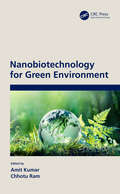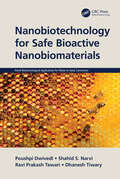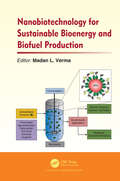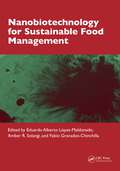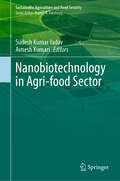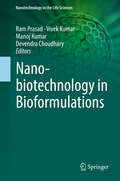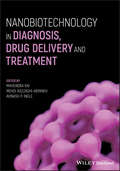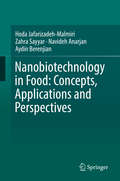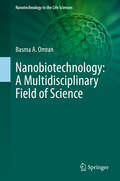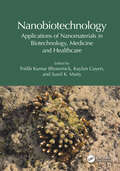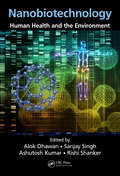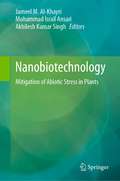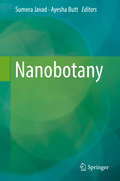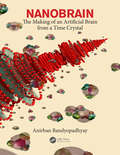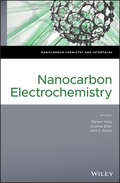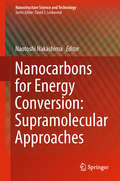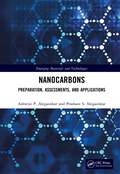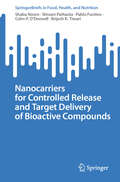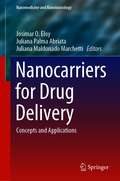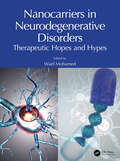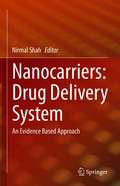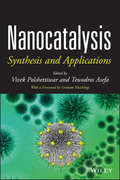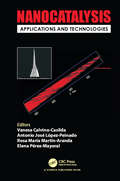- Table View
- List View
Nanobiotechnology for Green Environment
by Amit Kumar Chhotu RamThe book examines environmental issues and their solutions with advancements in biotechnology and nanotechnology. This book will focus on environmental friendly waste management, wastewater treatment, and utilization of wastes for energy. As humanity is struggling for clean air, water and even contaminant free food, our society must ponder the condition of environment. This book covers a variety of environmental issues and how they could be solved through innovations in science, engineering and technology. The authors examine the use of biotechnological methods to remediate wastewater, toxic organic compounds and sludge management problems. The topics include different research disciplines such as water and wastewater treatment, solid waste management and utilization of wastes for energy. This book will be useful for researchers, students, scientists and academicians who are working in multidisciplinary areas like microbiology, biotechnology, nanotechnology to address environmental issues such as water and wastewater treatment, solid waste management and energy resources. Nanobiotechnology for Green Environment covers a variety of environmental issues and how they could be solved through innovations in science, engineering and technology.
Nanobiotechnology for Safe Bioactive Nanobiomaterials (Novel Biotechnological Applications for Waste to Value Conversion)
by Dhanesh Tiwary Poushpi Dwivedi Shahid S. Narvi Ravi Prakash TewariThis book begins with an introduction of nanobiotechnology, followed by biosyntheses of AgNPs, development of silver/chitosan (Ag/CS) polymer nanocomposites, synthesis of silver/chitosan-g-poly acrylamide (Ag/CS-g-PAAm) nanocomposite hydrogel and silver/chitosan/poly vinyl chloride (Ag/CS/PVC) blend. Finally, it presents novel bioengineering of polyfunctional metallic nanostructures other than Ag, emphasizing biomass utilization and value-added conversion over an extended span, including life cycle assessment of the synthesized nanostructures. Features: Includes prospective cost effective, eco-friendly, and safe nanomaterials, synthesized through facile paths Covers the synergistic effect of phytochemicals and nano-Ag antimicrobial agents from an antiviral perspective Includes surface coating systems and super absorbent materials for biomedical purposes Examines nanobiotechnological applications for generating nanoalloys with synchronized nanostructural arrangement of alkaline earth metals and nanoscale dots of transition metals Explores the life cycle assessment of synthesized nanomaterials This book aims at researchers and graduate students in biomaterials, chemical engineering, green chemistry, nanomaterials, and biotechnology.
Nanobiotechnology for Sustainable Bioenergy and Biofuel Production
by Madan L. VermaNanobiotechnology for Sustainable Bioenergy and Biofuel Production provides insights into the most recent innovations, trends, concerns and challenges in the production of biofuels. This book highlights a number of key research topics and practical applications of modern nanomaterials and nanocomposite-driven enzyme biotechnology for biofuels production, including the advances in the nanoscaffolds design (nanomaterials support) for immobilizing bioenergy producing enzymes (nanobiocatalyst system), the recent trends in biomass processing (untreated/treated agriculture and food waste, grasses, algal, etc.) using advanced nanobiocatalysts for biofuels production and the scale-up study of bioenergy production using nanomaterials immobilized enzymes and biofuel harvesting using nanomaterials. At the outset of new nanobiotechnology applications in biofuel production, there is a need for a new resource in the bioenergy field. This book delivers an overview of the contributions of biofuel production and the most up-to-date advances in nanobiotechnology to a diverse audience ranging from post-graduate students to researchers in biochemical engineering, biotechnology, bioremediation and environmental studies and pharmaceutical professionals. Key Features • Outlines the most recent nanobiotechnological advances in biofuels and bioenergy for biofuels productions • Covers biodiesel, bioethanol, biomethane, biohydrogen, biorefineries and biofuel harvesting using nanomaterials • Explains the scale-up nanobiotechnological study of biofuel production at the bioreactor level
Nanobiotechnology for Sustainable Food Management
by Amber R. Solangi Fabio Granados-Chinchilla López-Maldonado, Eduardo AlbertoAmong the most novel and ever-growing approaches to improving the food industry is nanobiotechnology. In this book, the prospective role of nanobiotechnology in food which includes quality control and safety through nanosensors and biosensors, targeted delivery of nutrients, controlled release of nutrients, proteins, antioxidants, and flavors through encapsulation and enzymatic reactions for food fortification of fat-soluble compounds is discussed. Along the chapters of this book, nanobiotechnological techniques are addressed in detail with specific emphasis on food science applications.Features: Discusses nanobiotechnology in food for quality control and safety Covers food processing and packaging for food safety Explores the positive role of nanomaterials towards the sustainability of food Provides efficient, real, and sustainable solutions to pertinent global problems Includes case studies and research directions of the nanobiotechnology This book is aimed at researchers and graduate students in nanotechnology and food engineering.
Nanobiotechnology in Agri-food Sector (Sustainability Sciences in Asia and Africa)
by Sudesh Kumar Yadav Avnesh KumariThis book discusses the role of nanobiotechnology in genetic engineering, abiotic stress, nanobionics, postharvest reduction, soilless farming, climate change, precision agriculture, food packaging and processing. The chapters provide a systematic approach to the applications of nanobiotechnology in the agri-food sector. Nanotechnology provides various methods, protocols and nanoparticles for improving the performance of existing methods and protocols. It has the potential to improve the agricultural productivity, efficiency of agrochemicals and augmentation of plant functions. In the food sector, nanotechnology can significantly contribute to food packaging and processing industries. This book covers the untapped potential of nanobiotechnology in improving the productivity, performance, and efficiency of the agri-food sector. This book aids researchers, academicians, and agriculture scientists and nanobiotechnologists in understanding the advantages and broad applications of nanobiotechnology in the agri-food sector.
Nanobiotechnology in Agriculture: An Approach Towards Sustainability (Nanotechnology in the Life Sciences)
by Khalid Rehman Hakeem Tanveer Bilal PirzadahAgriculture is considered as a backbone of developing nations as it caters the needs of the people, directly or indirectly. The global agriculture currently faces enormous challenges like land degradation and reduced soil fertility, shrinking of land, low production yield, water accessibility and a dearth of labor due to evacuation of individuals from farming. Besides, the global population increases at an exponential rate and it is predicted that the global population will be 9 billion by 2050 that in turn leads to food crisis in near future. Although, green revolution revolutionizes the agriculture sector by enhancing the yield but it was not considered as a sustainable approach. Exorbitant use of chemical fertilizers and pesticides to boost the crop yield is definitely not a convenient approach for agriculture sustainability in the light of the fact that these chemical fertilizers are considered as double-edged sword, which on one hand enhance the crop yield but at the same time possess deleterious effect on the soil microflora and thus declines its fertility. Besides, it cause irreversible damage to the soil texture and disrupts the equilibrium in the food chain across ecosystem, which might in turn lead to genetic mutations in future generations of consumers. Thus, the increased dependence on fabricated agricultural additives during and post green revolution has generated serious issues pertaining to sustainability, environmental impact and health hazards. Therefore, nano-biotechnology has emerged as a promising tool to tackle the above problems especially in the agriculture sector. Nano-agribusiness is an emerged field to enhance crop yield, rejuvenate soil health, provide precision farming and stimulate plant growth. Nano-biotechnology is an essential tool in modern agriculture and is considered as a primary economic driver in near future. It is evaluated that joining of cutting edge nanotechnology in agribusiness would push the worldwide monetary development to approximately US$ 3.4 trillion by 2020 which clearly indicates that how agri-nanobiotechnology plays a pivotal role in the agricultural sector, without any negative impact on the environment and other regulatory issues of biosafety. Agri-nanobiotechnology is an innovative green technology, which provides the solution to global food security, sustainability and climate change. The current book is presenting the role of nano-biotechnology in modern agriculture and how it plays a pivotal role to boost the agri-business.
Nanobiotechnology in Bioformulations (Nanotechnology in the Life Sciences)
by Manoj Kumar Ram Prasad Vivek Kumar Devendra ChoudharyWith the recent shift of chemical fertilizers and pesticides to organic agriculture, the employment of microbes that perform significant beneficial functions for plants has been highlighted. This book presents timely discussion and coverage on the use of microbial formulations, which range from powdered or charcoal-based to solution and secondary metabolite-based bioformulations. Bioformulation development of biofertilizers and biopesticides coupled with the advantages of nanobiotechnology propose significant applications in the agricultural section including nanobiosensors, nanoherbicides, and smart transport systems for the regulated release of agrochemical. Moreover, the formulation of secondary metabolites against individual phytopathogens could be used irrespective of geographical positions with higher disease incidences. The prospective advantages and uses of nanobiotechnology generate tremendous interest, as it could augment production of agricultural produce while being cost-effective both energetically and economically. This bioformulation approach is incomparable to existing technology, as the bioformulation would explicitly target the particular pathogen without harming the natural microbiome of the ecosystem.Nanobiotechnology in Bioformulations covers the constraints associated with large-scale development and commercialization of bioinoculant formations. Furthermore, exclusive emphasis is be placed on next-generation efficient bioinoculants having secondary metabolite formulations with longer shelf life and advanced competence against several phytopathogens. Valuable chapters deal with bioformulation strategies that use divergent groups of the microbiome and include detailed diagrammatic and pictorial representation. This book will be highly beneficial for both experts and novices in the fields of microbial bioformulation, nanotechnology, and nano-microbiotechnology. It discusses the prevailing status and applications available for microbial researchers and scientists, agronomists, students, environmentalists, agriculturists, and agribusiness professionals, as well as to anyone devoted to sustaining the ecosystem.
Nanobiotechnology in Diagnosis, Drug Delivery and Treatment
by Mahendra Rai Mehdi Razzaghi-Abyaneh Avinash P. InglePresents nanobiotechnology in drug delivery and disease management Featuring contributions from noted experts in the field, this book highlights recent advances in the nano-based drug delivery systems. It also covers the diagnosis and role of various nanomaterials in the management of infectious diseases and non-infectious disorders, such as cancers and other malignancies and their role in future medicine. Nanobiotechnology in Diagnosis, Drug Delivery and Treatment starts by introducing how nanotechnology has revolutionized drug delivery, diagnosis, and treatments of diseases. It then focuses on the role of various nanocomposites in diagnosis, drug delivery, and treatment of diseases like cancer, Alzheimer's disease, diabetes, and many others. Next, it discusses the application of a variety of nanomaterials in the diagnosis and management of gastrointestinal tract disorders. The book explains the concept of nanotheranostics in detail and its role in effective monitoring of drug response, targeted drug delivery, enhanced drug accumulation in the target tissues, sustained as well as triggered release of drugs, and reduction in adverse effects. Other chapters cover aptamer-incorporated nanoparticle systems; magnetic nanoparticles; theranostics and vaccines; toxicological concerns of nanomaterials used in nanomedicine; and more. Provides a concise overview of state-of-the-art nanomaterials and their application like drug delivery in infectious diseases and non-infectious disorders Highlights recent advances in the nano-based drug delivery systems and role of various nanomaterials Introduces nano-based sensors which detect various pathogens Covers the use of nanodevices in diagnostics and theranostics Nanobiotechnology in Diagnosis, Drug Delivery and Treatment is an ideal book for researchers and scientists working in various disciplines such as microbiology, biotechnology, nanotechnology, pharmaceutical biotechnology, pharmacology, pharmaceutics, and nanomedicine.
Nanobiotechnology in Food: Concepts, Applications and Perspectives
by Hoda Jafarizadeh-Malmiri Zahra Sayyar Navideh Anarjan Aydin BerenjianThis text focuses on the many benefits of the use of nanobiotechnology in the food industry. Each aspect of nanobiotechnology use is covered in depth, from food processing to packaging to safety and quality control. The authors outline the definition and history of nanobiotechnology and cover novel technologies for its use in the food industry, including the advantages and challenges for food scientists. Individual chapters focus on the food industry's use of nano-additives, nano-sensors, nano-encapsulation for nutrition delivery and considerations for commercialization. The potential hazards for nanoparticle use, as well as the future prospects of nanobiotechnology use in the food industry, are presented here in depth. Nanobiotechnology in Food: Concepts, Applications and Perspectives explores the emerging developments in nanotechnology which make it increasingly applicable to the food industry. Nanoparticles are applied during food processing to improve nutritional quality, flow properties, flavor, color and stability, and also to increase shelf life by decreasing the activity of microorganisms. Nanotechnology is important for the development of healthier foods with lower fat, sugar and salt levels, and to overcome many food-related diseases. This book shows how producers and manufacturers can make great strides in food quality and safety by using nanotechnology.
Nanobiotechnology: A Multidisciplinary Field of Science (Nanotechnology in the Life Sciences)
by Basma A. OmranThe generation of well-defined nanoparticles of excellent size and shape involves physical and chemical methodologies that are complicated, expensive, and produce hazardous toxic waste that is harmful to the environment and to human health. In order to combat the disadvantages of these methods, scientists have created “the biological method,” a new synthetic methodology that serves as a proper alternative to physical and chemical methodologies because of its easy utility, low cost, rapid synthesis, controlled size characteristics, controlled toxicity, and eco-friendliness. Nanobiotechnology is the science in which living matter can be manipulated and exploited to produce materials within the nano-scale. It is a multidisciplinary field of science framed by biology, chemistry, engineering, materials, and life sciences. Different biological entities can be exploited to yield biologically synthesized nanomaterials including bacteria, actinomycetes, yeast, fungi, viruses, algae, plant extracts, and agro-industrial waste extracts. This book represents a comprehensive review concerning the state of the art in nanobiotechnology, emphasizing the use of diverse biological entities in the science, and its versatile applications. It describes currently existing methodology with the latest published references, and provides safety information. It serves as the ideal guide for scientists interested in exploring nanobiotechnology.
Nanobiotechnology: Applications of Nanomaterials in Biotechnology, Medicine and Healthcare
by Kalyan Gayen Tridib Kumar Bhowmick Sunil K. MaityThis book covers topics related to drug delivery, biomaterials, drug design, formulation development, nanoscience, and nanotechnology. It describes the fundamental concepts in nanotechnology and their different applications in biotechnology to solve engineering challenges and generate new areas of technological development. Nanobiotechnology: Applications of Nanomaterials in Biotechnology, Medicine, and Healthcare covers vast application areas that include medical science, material science, pharmaceutical science, and environmental science. Section 1 presents recent research updates on the different nanomaterials, which are promising in different medical and biotechnological applications. Applications of nanomaterials as bone replacement orthopedic implants have revolutionized the treatment of orthopedic surgery. Nanostructured polymeric materials have gained immense research attention as therapeutic carriers for the precise delivery of drugs at targeted sites. Nanocellulose is recognized as a promising green nanomaterial due to its renewability and abundance in nature. Scientific topics on the most recent scientific and technological advances and applications of different nanostructured materials are presented in this section. Section 2 focuses on the novel synthesis methods that are used extensively and are promising for large-scale production of inorganic and nanostructured materials. Section 3 covers the applications of nanotools in the treatment of different diseases, including cancers and genetic diseases. The increasing use of nanotechnology will bring changes in the manufacturing processes of nanomaterials. The applications of nanomaterials in the field of medical imaging and molecular detection are presented in section 4. This book will be useful for students, researchers, scientists, academicians, and industrial manufacturers to understand the importance and applicability of nanomaterials in the field of biotechnology and medical science.
Nanobiotechnology: Human Health and the Environment
by Alok Dhawan, Sanjay Singh, Ashutosh Kumar and Rishi ShankerThis book combines the contributions from the experts of material science, molecular biology, toxicology bio-organic and bio-inorganic chemistry, toxicologists and environmental and food technology etc. to fathom the full scope of current and future of developments in the area of Nanobiotechnology. Provides brief overview of nanobiotechnology for general readers who are not familiar with the research fields and presents a strong overview of most of the critical areas in field This book can also be used as text book for graduate students as an essential reference material, and as an reading material for general readers having a curiosity in Nanobiotechnology.
Nanobiotechnology: Mitigation of Abiotic Stress in Plants
by Jameel M. Al-Khayri Akhilesh Kumar Singh Mohammad Israil AnsariThis book provides up-to-date knowledge of the promising field of Nanobiotechnology with emphasis on the mitigation approaches to combat plant abiotic stress factors, including drought, salinity, waterlog, temperature extremes, mineral nutrients, and heavy metals. These factors adversely affect the growth as well as yield of crop plants worldwide, especially under the global climate change. Nanobiotechnology is viewed to revolutionize crop productivity in future. The chapters discuss the status and prospects of this cutting-edge technology toward understanding tolerance mechanisms, including signaling molecules and enzymes regulation in addition to the applications of Nanobiotechnology to combat individual abiotic stress factors.
Nanobotany
by Sumera Javad Ayesha ButtThis work synthesizes research and practical work, including various techniques and applications of botany and nanoparticles, including enzymology, pharmaceuticals, phenolics, antioxidants, metal particles, synthesis of nanoparticles by plants and microbes, and more. The text discusses the latest research as well as key sources of information condensed from other scholars across the globe, providing a comprehensive resource for scholars working in nanobotany, as well as chemists and researchers in the pharmaceutical industry.
Nanobrain: The Making of an Artificial Brain from a Time Crystal
by Anirban BandyopadhyayMaking an artificial brain is not a part of artificial intelligence. It will be a revolutionary journey of mankind exploring a science where one cannot write an equation, a material will vibrate like geometric shape, and then those shapes will change to make decisions. Geometry of silence plays like a musical instrument to mimic a human brain; our thoughts, imagination, everything would be a 3D shape playing as music; composing music would be the brain’s singular job. For a century, the Turing machine ruled human civilization; it was believed that irrespective of complexity all events add up linearly. This book is a thesis to explore the science of decision-making where events are 3D-geometric shapes, events grow within and above, never side by side. The book documents inventions and discoveries in neuroscience, computer science, materials science, mathematics and chemistry that explore the possibility of brain or universe as a time crystal. The philosophy of Turing, the philosophy of membrane-based neuroscience and the philosophy of linear, sequential thought process are challenged here by considering that a nested time crystal encompasses the entire conscious universe. Instead of an algorithm, the pattern of maximum free will is generated mathematically and that very pattern is encoded in materials such that its natural vibration integrates random events exactly similar to the way nature does it in every remote corner of our universe. Find how an artificial brain avoids any necessity for algorithm or programming using the pattern of free will.
Nanocarbon Electrochemistry (Nanocarbon Chemistry and Interfaces)
by Nianjun YangProvides a comprehensive introduction to the field of nanocarbon electrochemistry The discoveries of new carbon materials such as fullerene, graphene, carbon nanotubes, graphene nanoribbon, carbon dots, and graphdiyne have triggered numerous research advances in the field of electrochemistry. This book brings together up-to-date accounts of the recent progress, developments, and achievements in the electrochemistry of different carbon materials, focusing on their unique properties and various applications. Nanocarbon Electrochemistry begins by looking at the studies of heterogeneous electron transfer at various carbon electrodes when redox-active molecules are reversibly and specifically adsorbed on the carbon electrode surface. It then covers electrochemical energy storage applications of various carbon materials, particularly the construction and performance of supercapacitors and batteries by use of graphene and related materials. Next, it concentrates on electrochemical energy conversion applications where electrocatalysis at 0D, 1D, 2D, and 3D carbon materials nanocarbon materials is highlighted. The book finishes with an examination of the contents of electrogenerated chemiluminescence and photoelectrochemical pollutant degradation by use of diamond and related carbon materials. Covers the fundamental properties of different carbon materials and their applications across a wide range of areas Provides sufficient background regarding different applications, which contributes to the understanding of specialists and non-specialists Examines nanoelectrochemistry of adsorption-coupled electron transfer at carbon electrodes; graphene and graphene related materials; diamond electrodes for the electrogenerated chemiluminescence; and more Features contributions from an international team of distinguished researchers Nanocarbon Electrochemistry is an ideal book for students, researchers, and industrial partners working on many diverse fields of electrochemistry, whether they already make frequent use of carbon electrodes in one form of another or are looking at electrodes for new applications.
Nanocarbons for Energy Conversion: Supramolecular Approaches (Nanostructure Science and Technology)
by Naotoshi NakashimaThis book focuses on nanocarbons (carbon nanotubes, graphene, nanoporous carbon, and carbon black) and related materials for energy conversion, including fuel cells (predominately proton exchange membrane fuel cells [PEMFC]), Li-ion batteries, and supercapacitors. Written by a group of internationally recognized researchers, it offers an in-depth review of the structure, properties, and functions of nanocarbons, and summarizes recent advances in the design, fabrication and characterization of nanocarbon-based catalysts for energy applications. As such, it is an invaluable resource for graduate students, academics and industrial scientists interested in the areas of nanocarbons, energy materials for fuel cells, batteries and supercapacitors as well as materials design, and supramolecular science.
Nanocarbons: Preparation, Assessments, and Applications (Emerging Materials and Technologies)
by Ashwini P. Alegaonkar Prashant S. AlegaonkarThis book provides a practical platform to the readers for facile preparation of various forms of carbon in its nano-format, investigates their structure–property relationship, and finally, realizes them for a variety of applications taking the route of application engineering. It covers the preparation and evaluation of nanocarbons, variety of carbon nanotubes, graphene, graphite, additively manufactured 3D carbon fibres, their properties, and various factors associated with them. A summary and outlook of the nanocarbon field is included in the appendices. Features: Presents comprehensive information on nanocarbon synthesis and properties and some specific applications Covers the growth of carbon nanoparticles, nanotubes, ribbons, graphene, graphene derivatives, porous/spongy phases, graphite, and 3D carbon fabrics Documents a large variety of characterizations and evaluations on the nature of growth causing effect on structure properties Contains dedicated chapters on miniaturized, flat, and 2D devices Discusses a variety of applications from military to public domains, including prevalent topics related to carbon. This book is aimed at researchers and graduate students in materials science and materials engineering, and physics.
Nanocarrier Vaccines: Biopharmaceutics-Based Fast Track Development
by Vasso Apostolopoulos Vivek P. ChavdaNANOCARRIER VACCINES This book details the benefits, restrictions, and types of nanoparticles used in the creation of vaccines for the treatment and prevention of illnesses. In nanomedicine and nano-delivery systems, materials in the nanoscale range are used as diagnostic instruments or to administer therapeutic compounds to particular targeted regions in a controlled manner. By delivering precise medications to specified locations and targets, nanotechnology provides several advantages in treating chronic human illnesses. The use of nanomedicine (including chemotherapeutic medicines, biological agents, immunotherapeutic agents, etc.) in the treatment of various diseases has recently seen many notable applications. This book aims to be a single source material for understanding all the current and novel advancements in the field of nanotechnology. In this groundbreaking book the reader will find: biodegradable and non-biodegradable formulations and properties such as size, shape, charge, inertness, efficacy, morphology, and more; show how different nanoparticles, such as lipid-based, viral vector-based, and metal, uphold very significant properties individually, suggesting applicability in various management tactics; examines how genetic information-carrying entities are becoming the norm for eradicating some diseases; gathers an exhaustive amount of information on routes of administration such as the oral route, mucosal immunity, intramuscular, subcutaneous, and intradermal; explores the legal regulations for nanotechnology-based approaches. Audience Researchers and pharmacy students in biomedical engineering and chemical engineering, biotechnology, as well as pharmaceutical and biopharmaceutical industry engineers working in drug discovery, chemical biology, computational chemistry, medicinal chemistry, and bioinformatics.
Nanocarriers for Controlled Release and Target Delivery of Bioactive Compounds (SpringerBriefs in Food, Health, and Nutrition)
by Brijesh K. Tiwari Colm P. O'Donnell Shivani Pathania Shaba Noore Pablo FuciñosThis brief provides a comprehensive overview of nanocarriers used for nanoencapsulation of bioactive compounds. It includes the basis of encapsulation mechanism, encapsulation efficiency, controlled release, target delivery, and its application in food, nutraceuticals, pharmaceuticals and cosmeceuticals.
Nanocarriers for Drug Delivery: Concepts and Applications (Nanomedicine and Nanotoxicology)
by Josimar O. Eloy Juliana Palma Abriata Juliana Maldonado MarchettiThis book covers basic aspects of different nanoparticles, including type of materials, lipid, polymeric and inorganic structures, synthesis strategies, as well as the main physicochemical characterization techniques. Moreover, this book addresses applications for both treatment and diagnosis of diseases, highlighting in vitro and in vivo findings and clinical evaluation. The chapters highlight the main barriers for drug delivery which can benefit from nanoencapsulation: the topical and oral routes. The main innovations in the field, such as gene therapy and functionalization of nanoparticles with a variety of moieties, including monoclonal antibodies for selective delivery, are discussed and illustrated with examples. Finally, the application of nanoparticles for drug delivery to cancer is reviewed considering toxicology and regulatory aspects.
Nanocarriers in Neurodegenerative Disorders: Therapeutic Hopes and Hypes
by Wael MohamedDue to the lack of secure, efficient, and patient-friendly therapies for neurodegenerative disorders, there is a rising demand for innovative approaches. Despite the limited number of nanocarriers approved for human use, they have demonstrated significant potential in preclinical and, in some instances, clinical trials. In alignment with this objective, the chapters of the book are structured to offer a comprehensive overview of recent advancements in medication and dosage form development, specifically emphasizing the nanoparticulate system for targeting the brain. This book aims to furnish readers with a thorough understanding of the clinical application of nanocarrier systems for treating neurodegenerative disorders, encompassing the latest developments, challenges, safety concerns, toxicity issues, regulatory considerations, prospects, and limitations. Individuals in academia, the scientific community, business, and education seeking a more effective approach to target the brain will find valuable insights in this resource.Key Features Provides a comparative perspective of various nanocarrier systems, therefore facilitating the researcher's selection of appropriate nanoparticulate carriers Highlights the related restrictions of brain delivery and current available medicines Includes information on the advantages and disadvantages of various biomaterials utilized in the development of nanocarriers for brain targeting Emphasizes distinct facets of surface functionalization according to the brain area of interest Presents the current advances, preclinical and clinical development, and the future potential of multiple brain-targeting technologies
Nanocarriers: An Evidence Based Approach
by Nirmal ShahA suitable drug delivery system is an essential element in achieving efficient therapeutic responses of drug molecules. With this desirability in mind, the book unites different techniques through which extremely small-sized particles can be utilized as a successful carrier for curing chronic as well as life-threatening diseased conditions. This is a highly informative and prudently organized book, providing scientific insight for readers with an interest in nanotechnology. Beginning with an overview of nanocarriers, the book impetuses on to explore other essential ways through which these carriers can be employed for drug delivery to varieties of administrative routes. This book discusses the functional and significant features of nanotechnology in terms of Lymphatic and other drug targeting deliveries. The book is presenting depth acquaintance for various vesicular and particulate nano-drug delivery carriers, utilized successfully in Pharmaceutical as well as in Cosmeceutical industries along with brief information on their related toxicities. In addition, the work also explores the potential applications of nanocarriers in biotechnology sciences for the prompt and safe delivery of nucleic acid, protein, and peptide-based drugs. An exclusive section in the book illuminates the prominence and competent applicability of nanotechnology in the treatment of oral cancer. The persistence of this book is to provide basic to advanced information for different novel carriers which are under scale-up consideration for the extensive commercialization. The book also includes recent discoveries and the latest patents of such nanocarriers. The cutting-edge evidence of these nanocarriers available in this book is beneficial to students, research scholars, and fellows for promoting their advanced research.
Nanocatalysis
by Vivek Polshettiwar Tewodros Asefa Graham HutchingsExhibiting both homogeneous and heterogeneous catalytic properties, nanocatalysts allow for rapid and selective chemical transformations, with the benefits of excellent product yield and ease of catalyst separation and recovery. This book reviews the catalytic performance and the synthesis and characterization of nanocatalysts, examining the current state of the art and pointing the way towards new avenues of research. Moreover, the authors discuss new and emerging applications of nanocatalysts and nanocatalysis, from pharmaceuticals to fine chemicals to renewable energy to biotransformations.Nanocatalysis features contributions from leading research groups around the world. These contributions reflect a thorough review of the current literature as well as the authors' first-hand experience designing and synthesizing nanocatalysts and developing new applications for them. The book's nineteen chapters offer a broad perspective, covering:Nanocatalysis for carbon-carbon and carbon-heteroatom coupling reactionsNanocatalysis for various organic transformations in fine chemical synthesisNanocatalysis for oxidation, hydrogenation, and other related reactionsNanomaterial-based photocatalysis and biocatalysisNanocatalysts to produce non-conventional energy such as hydrogen and biofuelsNanocatalysts and nano-biocatalysts in the chemical industryReaders will also learn about the latest spectroscopic and microscopy tools used in advanced characterization methods that shed new light on nanocatalysts and nanocatalysis. Moreover, the authors offer expert advice to help readers develop strategies to improve catalytic performance.Summarizing and reviewing all the most important advances in nanocatalysis over the last two decades, this book explains the many advantages of nanocatalysts over conventional homogeneous and heterogeneous catalysts, providing the information and guidance needed for designing green, sustainable catalytic processes.
Nanocatalysis: Applications and Technologies
by Vanesa Calvino-Casilda Antonio José López-Peinado Rosa María Martín-Aranda Elena Pérez MayoralSynthesis and design of new nanocatalysts is an important area of research that aims to introduce multiple types of useful applications in a greener market. The necessity of nanostructuring the active sites has emerged as the key point in a successful design of the catalysts. The book covers the progress in this research area done in the last ten years. It includes the classification of catalysts and structure of active sites at the nanoscale. The book covers examples to present the concept, evolution of nanocatalysts from the perspective of chemistry of materials and their applications.
